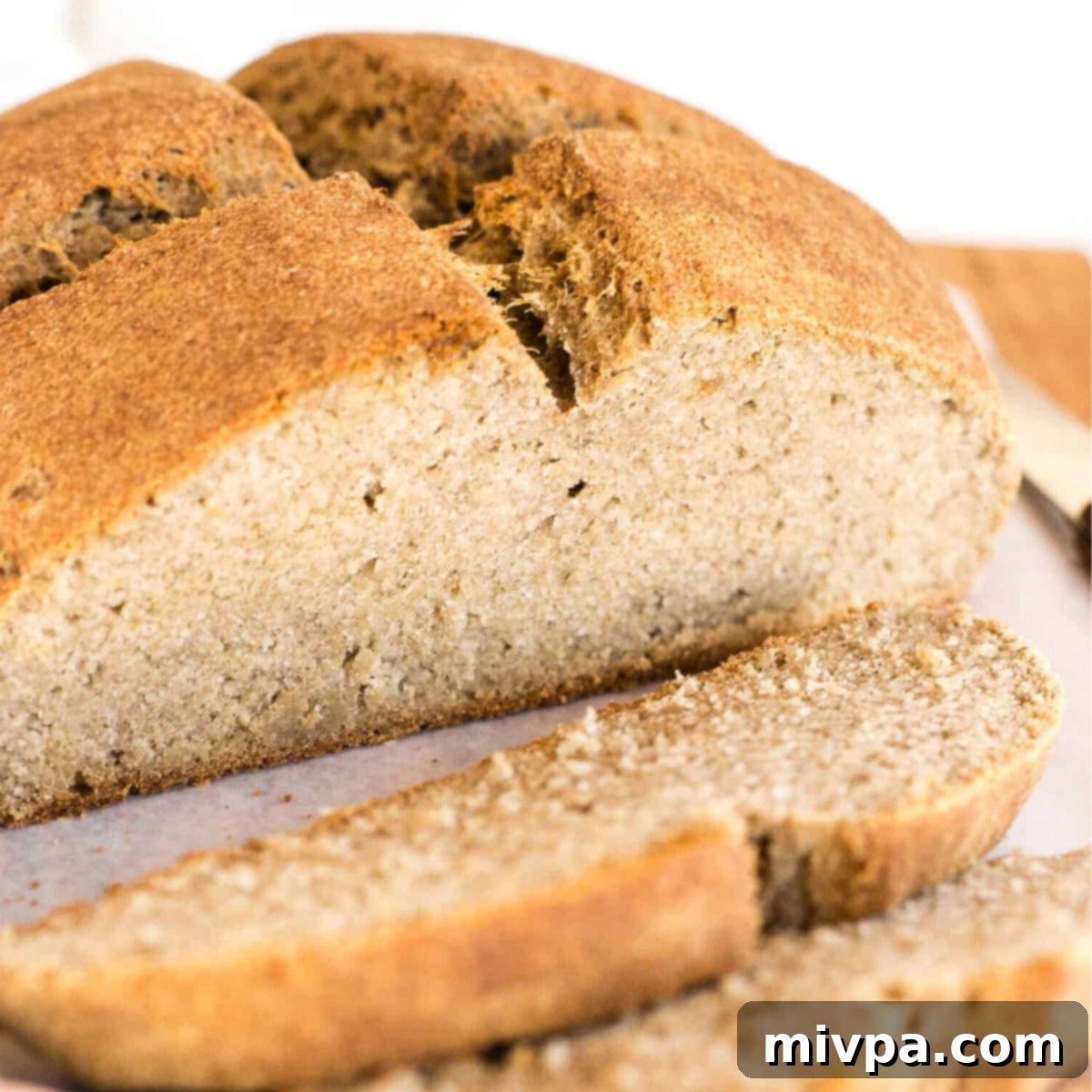Authentic Gluten-Free Irish Brown Bread: Easy, No-Knead, Dairy-Free & Vegan!
In just about an hour, you can have a warm, hearty loaf of this incredible gluten-free Irish brown bread gracing your table. It’s incredibly simple to make, requiring absolutely no kneading – perfect for beginners and busy bakers alike! With its characteristic tight crumb, reminiscent of traditional soda bread, and a subtle sweetness from maple syrup, this bread is a delightful treat for St. Patrick’s Day or any day you crave wholesome homemade goodness. Plus, it’s entirely dairy-free and vegan, ensuring everyone can enjoy a slice without compromise.
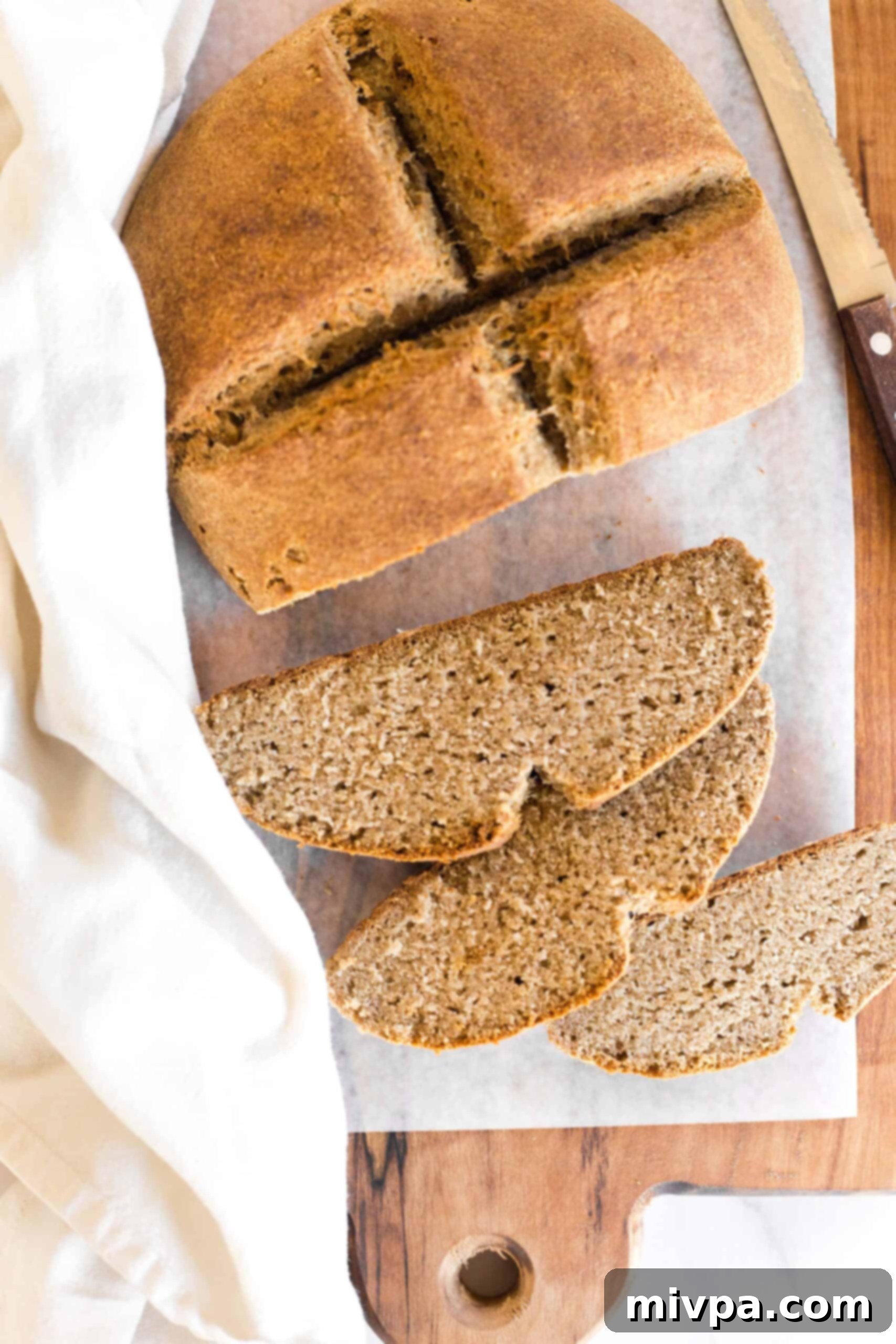
Embrace the Joy of Homemade Bread Baking
For those who have followed my culinary adventures here at Dish by Dish, you’ll know that my love for homemade bread runs deep. There’s something incredibly satisfying about the aroma of a freshly baked loaf filling the kitchen, a simple pleasure that transforms any meal.
My weekly routine often includes baking a new loaf, exploring various textures and flavors. While I adore classic yeast breads like our beloved buckwheat bread, the remarkably soft gluten-free white bread, the fluffy brown rice bread, and the comforting potato bread, there are many days when time is a luxury.
On those busy days, yeast-free breads become my saving grace. They offer all the warmth and flavor of homemade bread without the waiting game. Some of our cherished quick bread recipes include the delightful honey oat bread, the effortlessly delicious gluten-free naan bread, and of course, the ever-popular Irish soda bread.
Today, we’re diving into a particularly special recipe: a gorgeous loaf of Irish brown soda bread. It’s not just a staple; it’s a perfect way to celebrate traditions, especially around Saint Patrick’s Day. So, let’s roll up our sleeves and get baking!
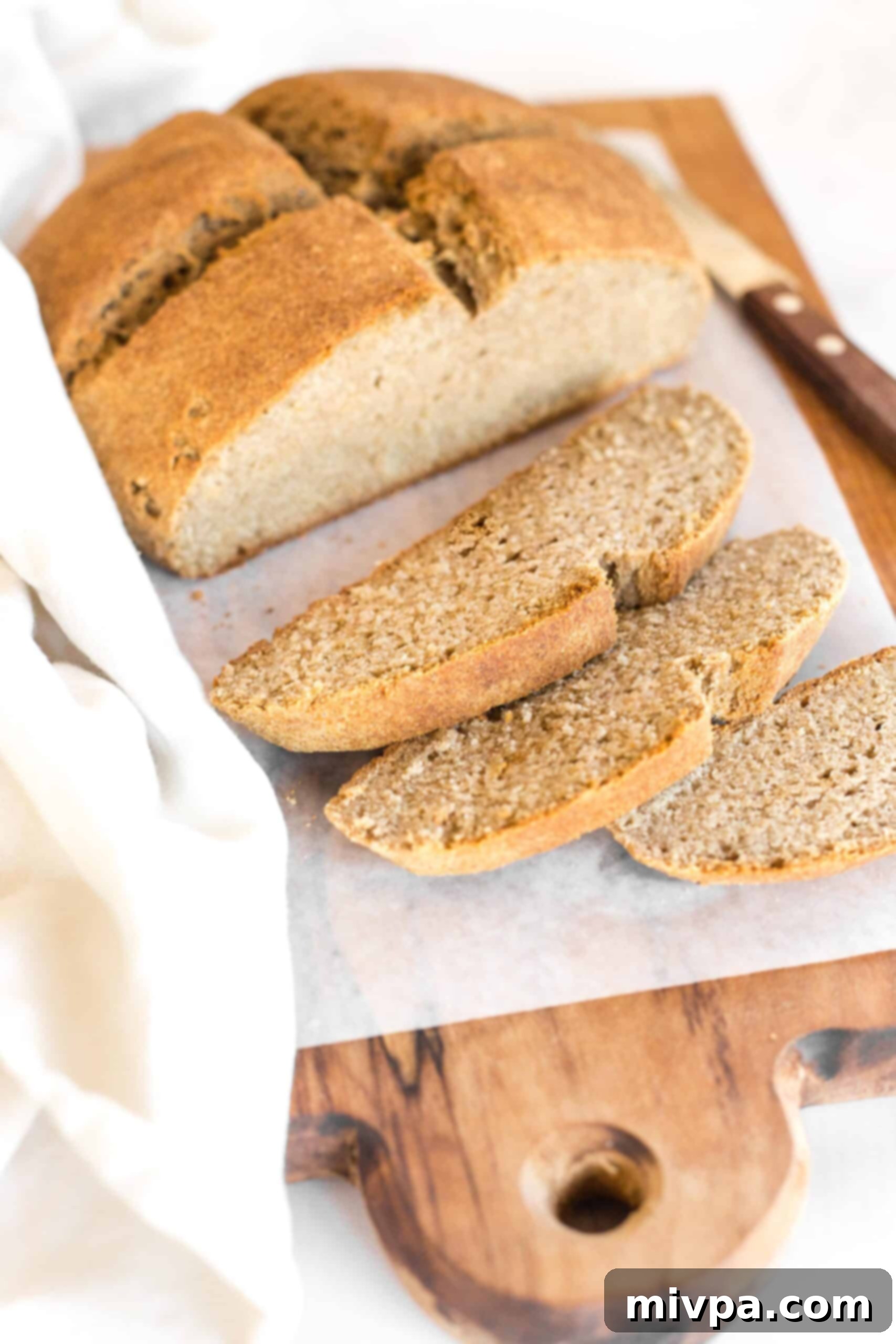
What is Traditional Irish Brown Bread?
Irish brown bread is a beloved staple in Ireland, known for its rustic charm and wholesome flavor. Essentially, it’s a whole-grain variation of the more widely known traditional Irish soda bread. You’ll instantly recognize it by its signature round shape and the distinctive cross cut on top of the loaf, a hallmark of this classic bake.
This bread boasts a wonderfully crunchy crust that gives way to a tender, yet dense crumb. Its robust texture and slightly tangy flavor make it an ideal accompaniment to hearty Irish stews, comforting soups, or simply slathered with butter alongside your morning tea.
(Fun fact: The cross cut on top of the dough isn’t just for aesthetics! It serves a practical purpose: allowing heat to penetrate the dough more effectively as it bakes. This ensures that the center of the loaf cooks evenly, resulting in a perfectly baked bread every time.)
A key characteristic that sets Irish brown bread apart is its leavening method. Unlike many conventional breads, it relies on baking soda and baking powder rather than yeast. This means no lengthy proofing times! The reaction of these leavening agents with an acidic ingredient (like buttermilk) creates the rise, producing a hearty loaf with a distinctively tight crumb and a denser, almost scone-like texture compared to lighter, yeasted breads.
Is Irish Brown Bread Traditionally Gluten-Free?
Regrettably, traditional Irish brown soda bread, in its authentic form, is made with whole wheat flour. Since whole wheat flour contains gluten, this classic bread is not suitable for individuals with Celiac disease or those who are sensitive to gluten. Unless a recipe explicitly states it uses certified gluten-free ingredients and is prepared in a gluten-free environment, it’s best to assume traditional versions contain gluten.
Our Delicious Gluten-Free & Vegan Irish Brown Soda Bread
But don’t despair! My mission is to make delicious food accessible to everyone, which is why I’ve developed this incredible gluten-free version of Irish brown bread. We’re replacing the conventional wholemeal flour with a carefully crafted blend of nutritious whole-grain gluten-free flours. Specifically, this recipe utilizes brown rice flour, millet flour, and sorghum flour, creating a rich flavor profile and a satisfying texture that truly mimics the original without any gluten.
What’s more, this recipe is also completely vegan and dairy-free, using plant-based ingredients to achieve the perfect rise and crumb. This means whether you’re avoiding gluten, dairy, or following a vegan lifestyle, you can still indulge in a warm slice of this rustic, wholesome bread.
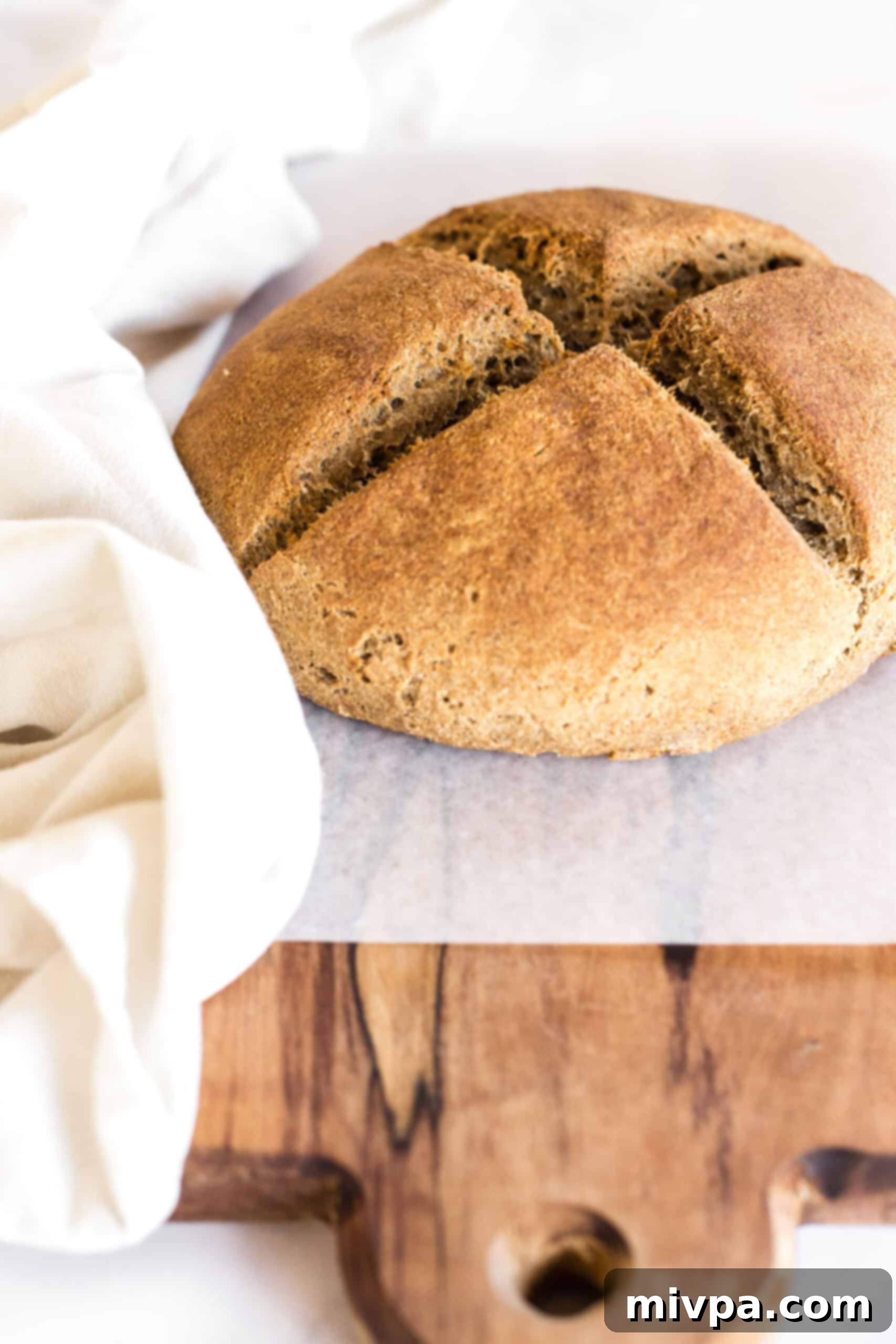
Why You’ll Love This Gluten-Free Irish Brown Bread Recipe:
- Simple, Accessible Ingredients: You won’t need to hunt for obscure ingredients! This recipe calls for basic staples that are readily available at your local grocery store, and chances are, many of them are already in your pantry. We focus on common gluten-free flours and everyday baking essentials.
- Effortlessly Easy & No Kneading Required: Say goodbye to strenuous kneading! The beauty of soda bread lies in its simplicity. All you need to do is gently combine the wet and dry ingredients to form a uniform dough. A quick shape into a rustic ball, a simple cross cut on top, and it’s ready for the oven. This ease makes it perfect for novice bakers and seasoned pros who appreciate a quick, fuss-free recipe.
- No Yeast or Lengthy Rising Time Needed: Tired of waiting for dough to rise? This recipe is your answer! By utilizing baking soda and baking powder as its leavening agents, this brown Irish soda bread skips the yeast and the associated proofing time. From start to finish, you can have a warm, delicious loaf ready to enjoy in under an hour – instant gratification for your bread cravings!
- Completely Gluten-Free, Dairy-Free, and Vegan: This is truly an inclusive recipe! Every bite of this wholesome brown bread is 100% gluten-free, making it safe for those with Celiac disease or gluten intolerance. Moreover, it’s entirely dairy-free and vegan, ensuring that individuals with lactose intolerance or those following a plant-based diet can enjoy a traditional taste of Ireland without any worries.
Key Ingredients for Your Gluten-Free Irish Brown Bread:
Curious about what goes into this delicious, wholesome loaf? Here’s a quick visual overview of the essential ingredients for our gluten-free Irish brown soda bread. These are thoughtfully chosen to ensure both authentic flavor and dietary compatibility.
(For precise measurements and detailed instructions, please refer to the comprehensive printable recipe card conveniently located at the very bottom of this post.)
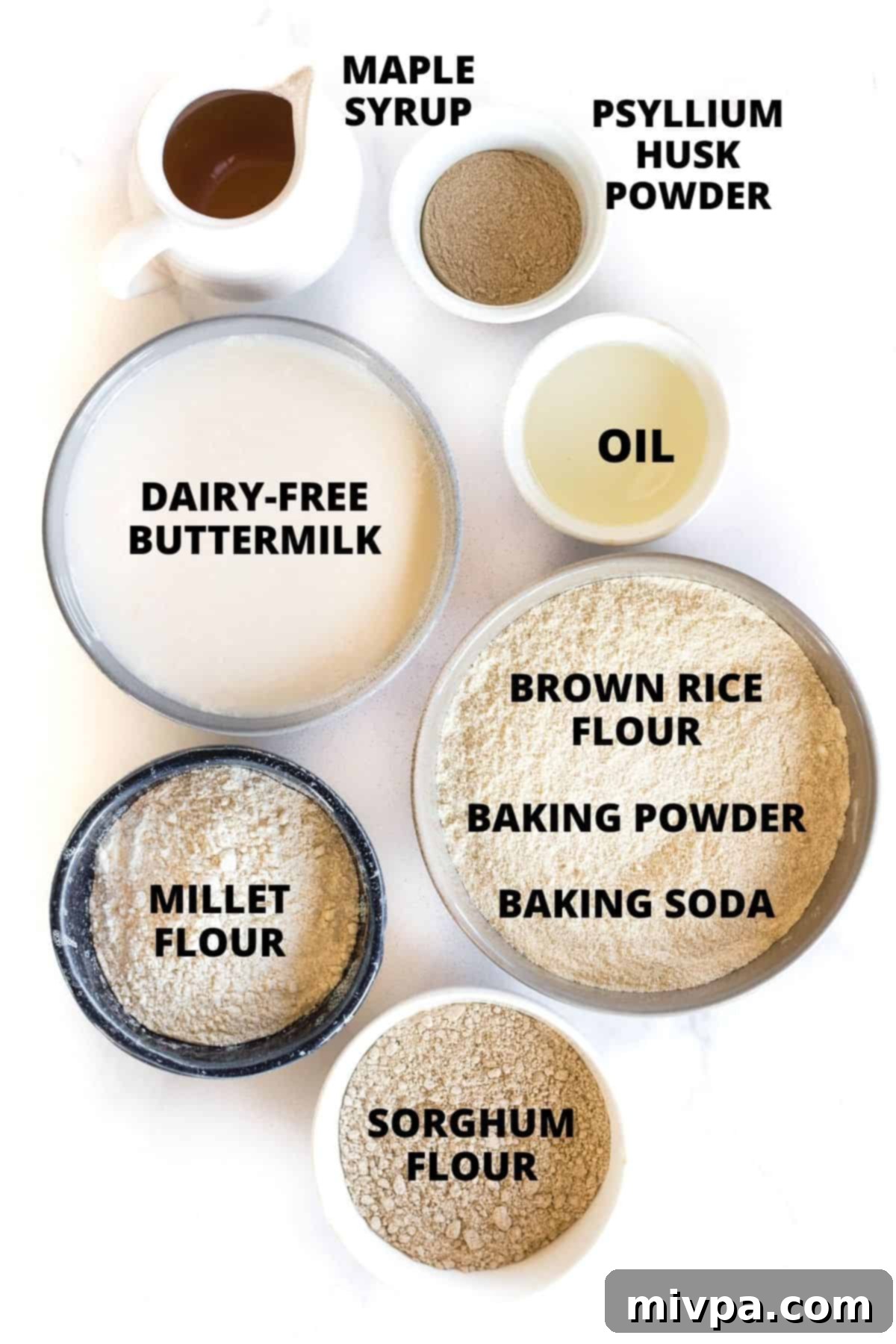
Ingredient Notes & Helpful Substitutions:
- Brown Rice Flour: This forms the foundational base of our gluten-free brown bread, contributing a wholesome texture and mild flavor. While I highly recommend it, a good-quality gluten-free all-purpose flour blend (ensure it’s designed for baking and contains a binder) can be used as an alternative if you prefer.
- Millet Flour: Millet flour adds a subtle sweetness and a tender crumb. You can easily make your own millet flour at home, or purchase it pre-packaged online or in stores. If millet flour isn’t available, excellent substitutes include sorghum flour, amaranth flour, or even buckwheat flour, each offering slightly different flavor notes.
- Sorghum Flour: Known for its mild flavor and soft texture, sorghum flour complements the other flours beautifully. If you need a substitute, consider millet flour, amaranth flour, oat flour (ensure it’s certified gluten-free), or buckwheat flour.
- Psyllium Husk Powder: This ingredient is a true MVP in gluten-free baking. Psyllium husk powder acts as a powerful binder, effectively replacing the role of gluten by providing structure and elasticity to the dough, preventing it from crumbling. It’s crucial to use the finely ground powder version for best results. If you only have access to whole psyllium husks, you can easily grind them into a fine powder using a high-speed blender or a coffee grinder.
- Baking Soda: A cornerstone of Irish soda bread, baking soda is vital for the chemical leavening process. When it reacts with the acidic buttermilk, it produces carbon dioxide bubbles, giving the bread its rise and characteristic texture.
- Baking Powder: To provide an extra lift and ensure a wonderfully airy (yet dense) crumb, we incorporate baking powder alongside baking soda. If you have Celiac disease or are strictly gluten-intolerant, always double-check to use a certified gluten-free baking powder to avoid any cross-contamination.
- Maple Syrup: I love the natural, nuanced sweetness that maple syrup imparts to this gluten-free Irish brown bread. It’s a perfect plant-based sweetener. Other excellent liquid sweetener options include molasses (which will also add a deeper color and richer flavor, true to some brown bread styles) or agave nectar. If you prefer to use brown sugar, remember to dissolve it in 2 tablespoons of warm water or additional dairy-free buttermilk before adding it to the wet ingredients. For non-vegans, honey can also be used.
- Dairy-Free Buttermilk: The acidity in buttermilk is crucial for activating the baking soda, creating the necessary rise. To make your own dairy-free version, simply combine 2 cups of your preferred non-dairy milk (such as almond milk or cashew milk) with 2 tablespoons of white vinegar or lemon juice. Let it sit for about 5-10 minutes until it slightly curdles. For best results, I recommend warming this dairy-free buttermilk mixture gently before adding it to the dry ingredients, as this helps activate the leavening agents more effectively. If you are not lactose-intolerant, regular buttermilk works perfectly fine too.
- Sunflower Oil: Sunflower oil is my go-to for its neutral flavor and accessibility. However, feel free to substitute with another mild-flavored vegetable oil like light olive oil, avocado oil, or melted coconut oil. Ensure coconut oil is melted and slightly cooled if using.
Step-by-Step Guide: How to Bake Your Gluten-Free Irish Brown Bread
Prepare the Dough
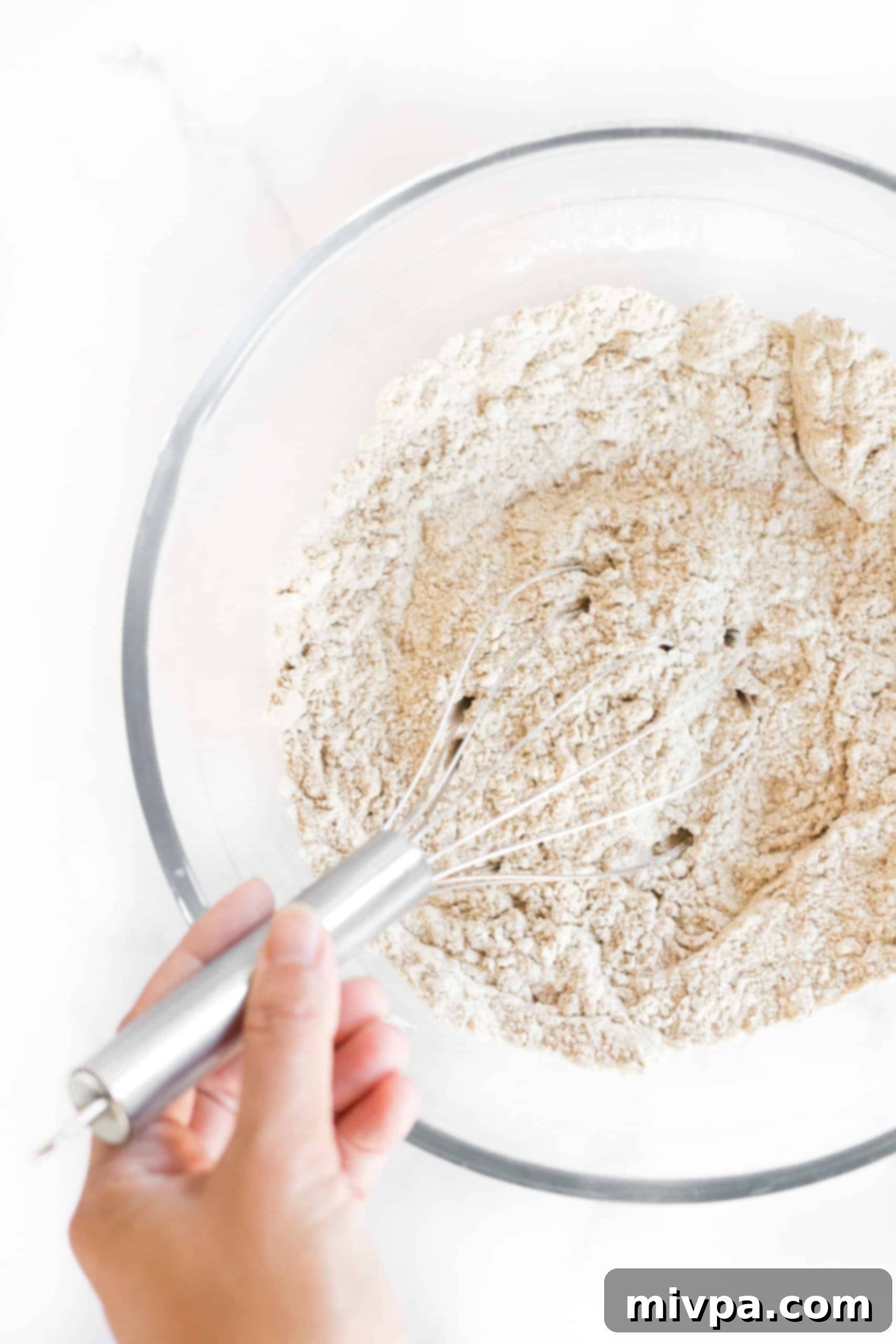
1. Whisk Dry Ingredients: In a spacious mixing bowl, meticulously combine the brown rice flour, millet flour, sorghum flour, psyllium husk powder, baking soda, and baking powder. Whisk these ingredients together very thoroughly to ensure they are fully incorporated and evenly distributed. This step is crucial for an even rise and texture.
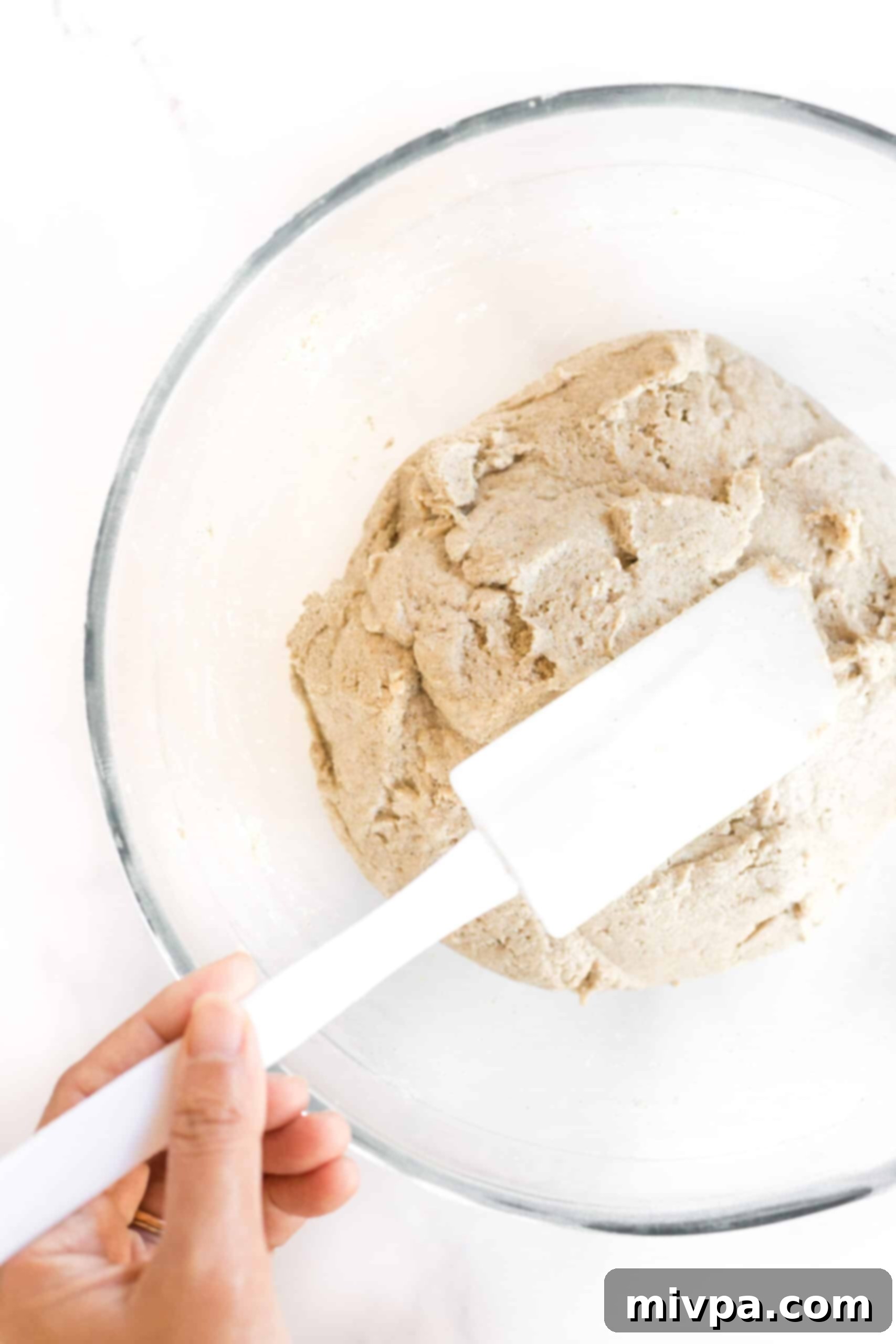
2. Add Wet Ingredients to Form Dough: Introduce the maple syrup, the pre-warmed dairy-free buttermilk mixture, and the sunflower oil into the large bowl containing your dry ingredients. Mix these together thoroughly until you achieve a thick, yet homogeneous dough. Don’t worry if the dough feels slightly sticky; this is perfectly normal and expected for this type of bread. Avoid overmixing, just combine until no dry streaks remain.
Shape Dough and Cut a Cross
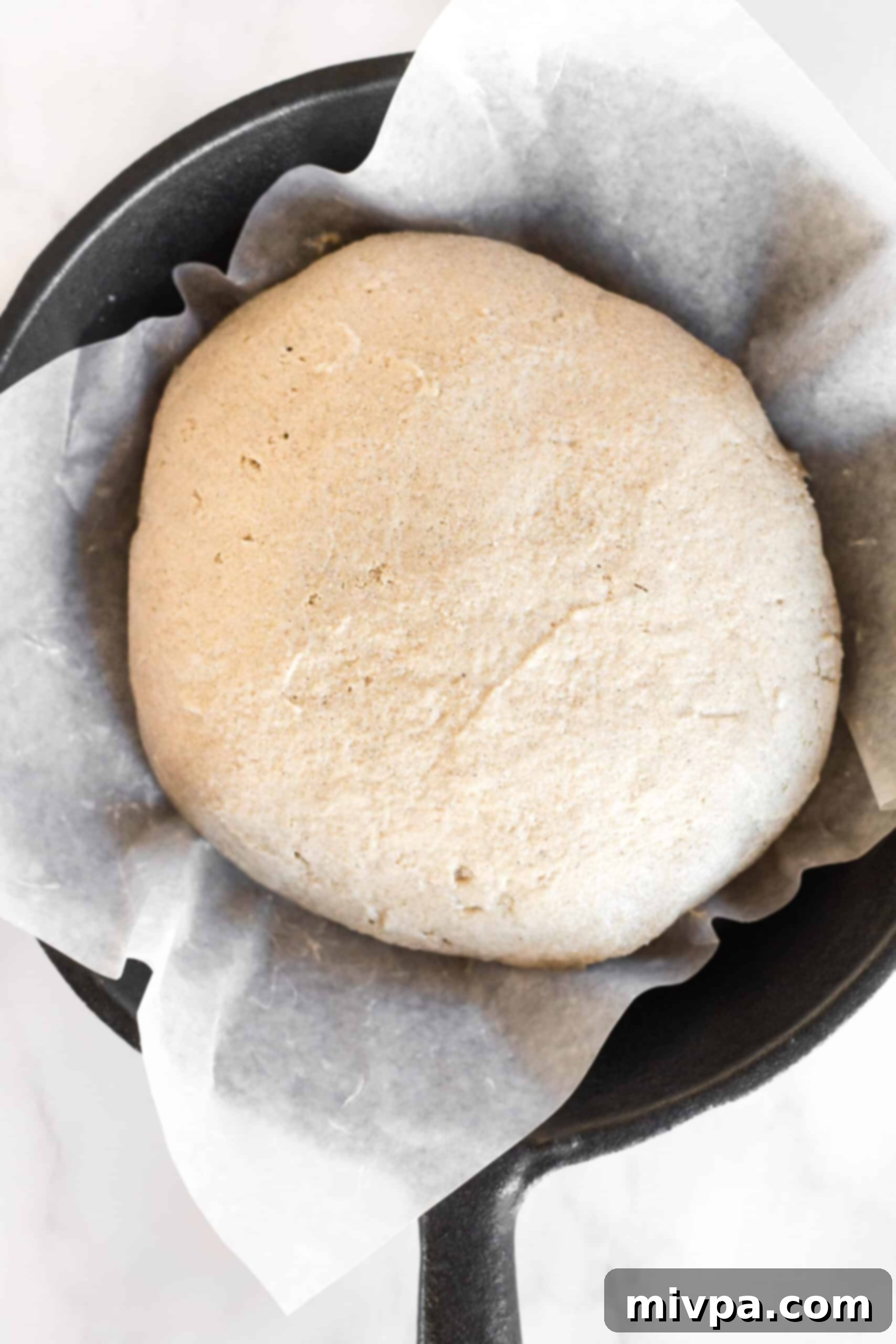
3. Shape Dough into a Ball: With lightly floured hands (or oiled hands if it’s too sticky), gently shape the dough into a cohesive round ball. Carefully transfer this dough ball to your prepared cast iron skillet or baking sheet that has been lined with parchment paper. This parchment lining is essential to prevent sticking.
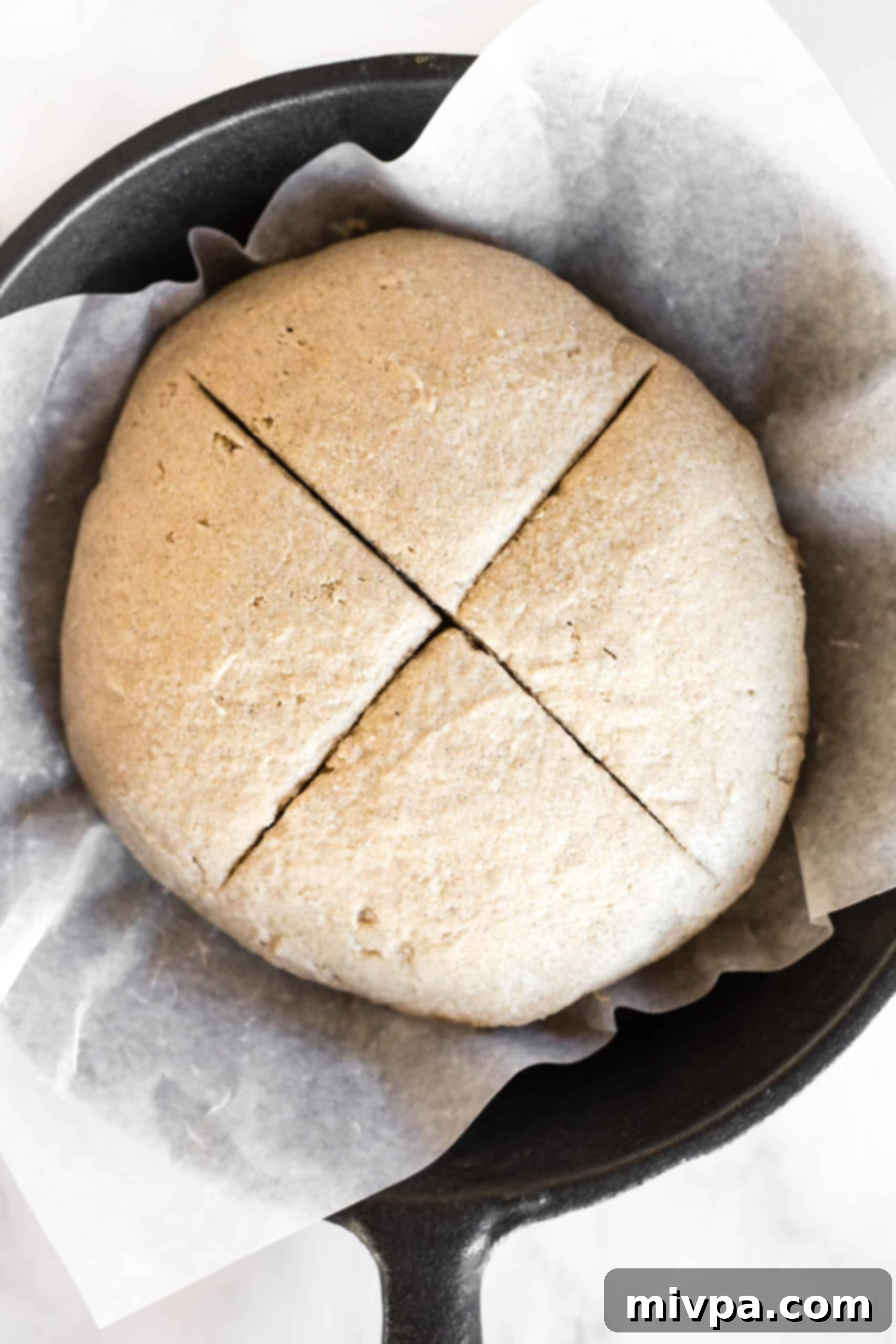
4. Cut a Cross on Top of Dough: Using a sharp, smooth-edged knife (you can slightly flour it to prevent sticking), carefully cut a deep cross on the top surface of the dough. Make sure these two perpendicular lines extend almost to the edges of the dough and are deep enough, roughly two-thirds of the way down. This traditional mark isn’t just symbolic; it helps the bread bake evenly and creates a beautiful rustic appearance.
Bake, Cool, and Savor!

5. Bake Until Golden Brown: Place your prepared dough in the preheated oven and bake at 350°F (175°C) for approximately 50 minutes. The bread is ready when the top is beautifully golden brown, and a wooden skewer or toothpick inserted into the very center comes out clean, indicating it’s fully cooked through.
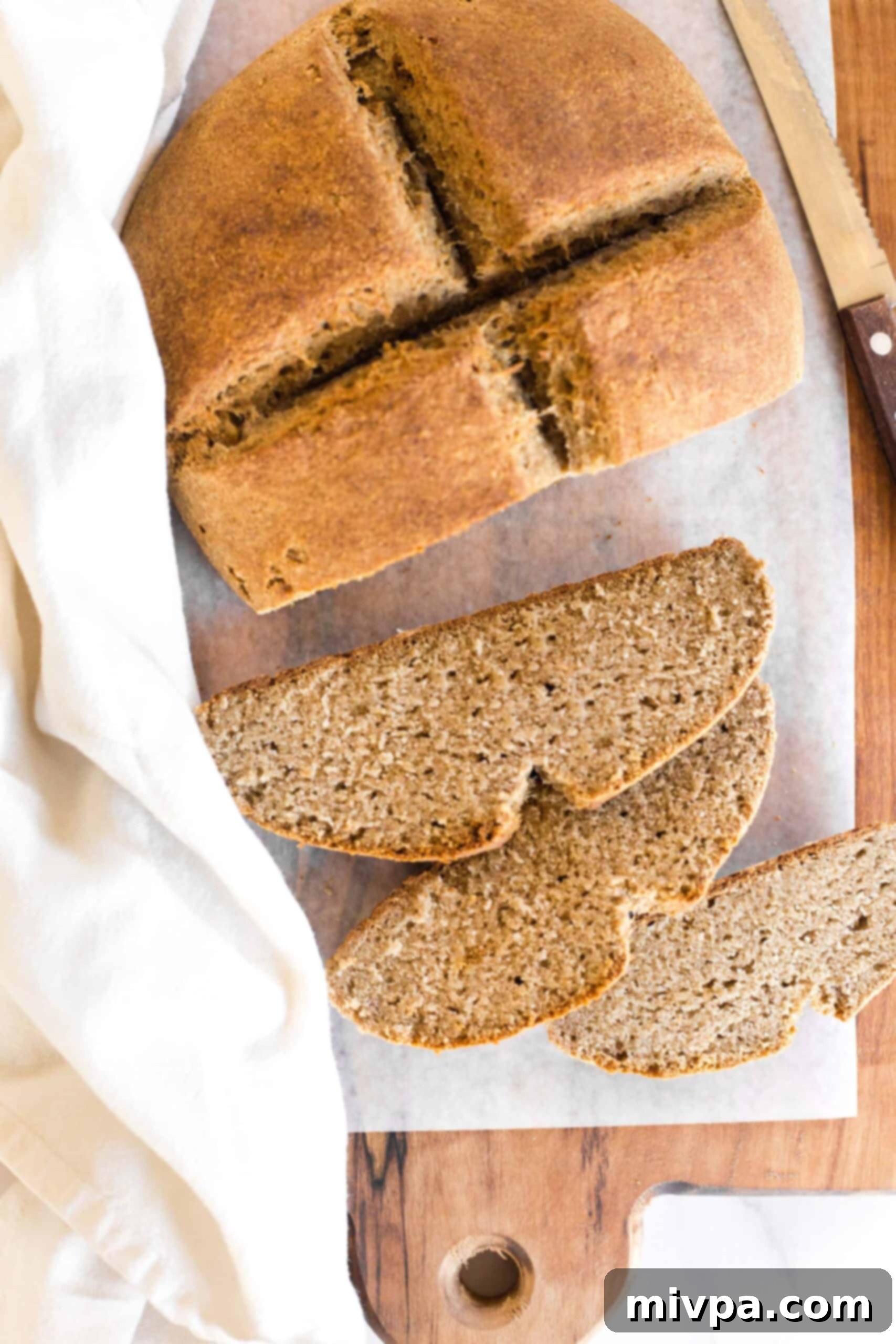
6. Cool Completely Before Slicing: This is perhaps the hardest step – waiting! It’s crucial to let the freshly baked loaf of delicious brown bread cool completely on a wire rack. Cooling allows the internal structure to set properly and prevents a gummy texture. Resist the urge to slice it warm; patience will be rewarded with the best crumb and flavor. Once cooled, slice and enjoy!
Dish by Dish Pro Tips & Tricks for the Perfect Loaf:
- Optional Flavorful Add-Ins: Elevate your brown bread with some delicious additions! Feel free to gently fold in about ½ cup of raisins, chopped walnuts, or even traditional caraway seeds into the dough. These add-ins will introduce extra layers of flavor and delightful textural contrasts.
- Make it Savory: While this recipe includes a hint of sweetness, you can easily adapt it for a more savory profile. Simply omit the maple syrup entirely and add an additional pinch of salt (or to taste) to the dry ingredients. This savory version pairs wonderfully with cheese or alongside a hearty dinner.
- Craving a Whiter Bread?: If your preference leans towards a lighter, “whiter” loaf, you can adjust the flour blend. Replace half of the whole-grain gluten-free flours (brown rice, millet, sorghum) with an equal amount of all-purpose gluten-free white flour blend. Alternatively, for a completely different but equally delicious option, try my dedicated gluten-free Irish soda bread recipe.
- Always Line with Parchment Paper: A simple step that makes a huge difference! Always line your cast iron pan or baking sheet with parchment paper. This crucial step ensures that the bottom of your beautiful loaf doesn’t stick to the pan, guaranteeing easy removal and a perfectly intact crust.
- No Cast Iron Pan? No Problem! Don’t have a cast iron pan? You can absolutely still make this bread! A Dutch oven with a lid (remove the lid for the last 15-20 minutes to achieve a golden crust) or even a regular large baking sheet will work just as well. Just ensure your baking sheet is adequately lined.
- Prefer a Loaf Pan? While I adore the rustic, traditional round shape that this gluten-free brown bread takes on in a skillet (as seen in the photos), you are welcome to bake it in a standard loaf pan if you prefer. The baking time might need slight adjustment, so keep an eye on it.
- Perfect Pairing with Stew: This wholesome gluten-free brown soda bread is an absolute dream when served with a steaming, rich bowl of hearty beef stew. Its dense texture and earthy flavor make it ideal for soaking up every last drop of flavorful broth.
- Prevent Over-Browning: If you notice the top of your bread browning too quickly before the inside is fully cooked, simply tent the loaf loosely with aluminum foil for the remainder of the baking time. This will protect the crust from burning while allowing the interior to finish baking perfectly.
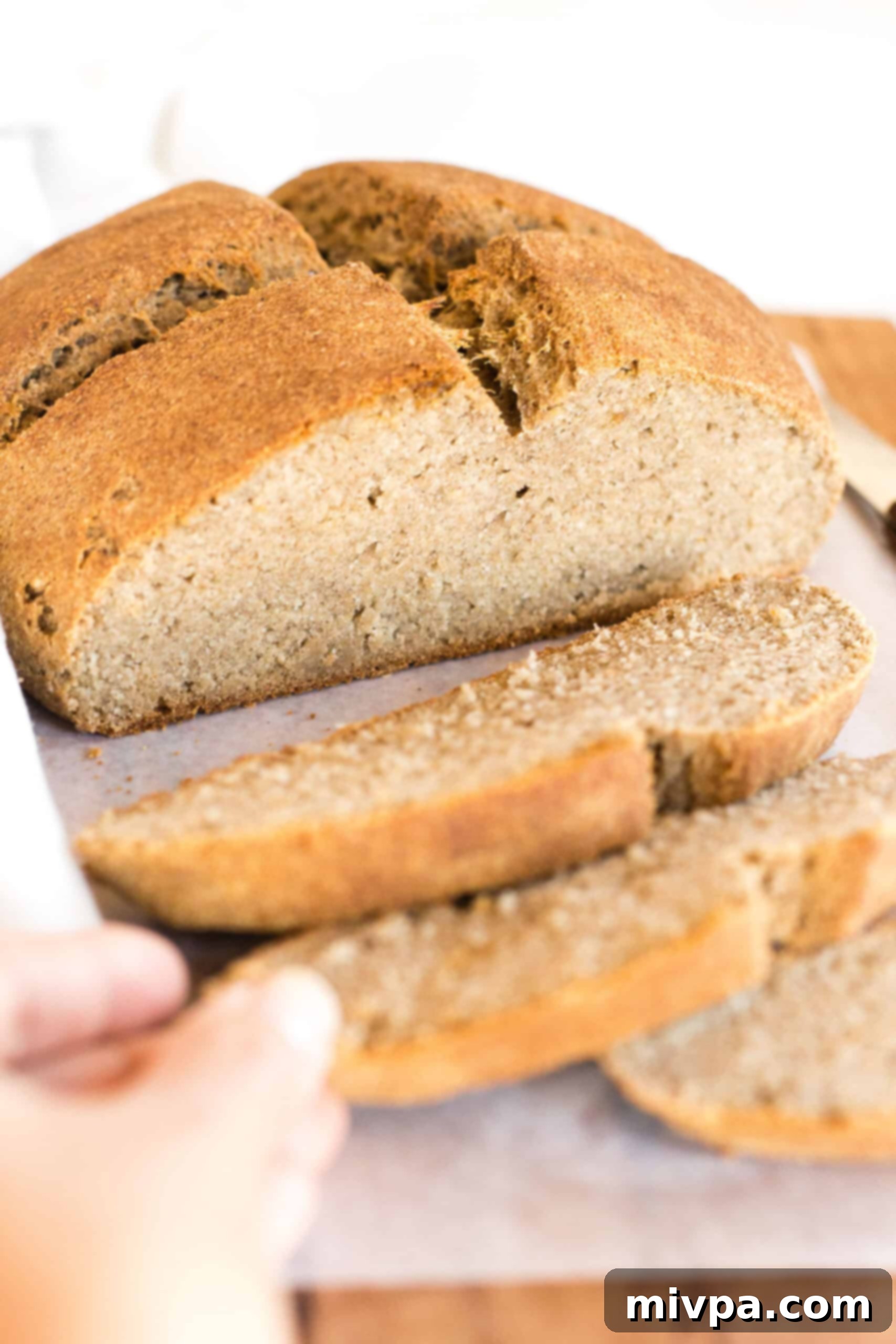
Frequently Asked Questions (FAQs)
To maintain its freshness, once the bread has completely cooled to room temperature, place it in an airtight container or a resealable plastic bag. Store it in the refrigerator, where it will keep well for up to 5 days. For optimal texture, you can lightly toast slices before serving if they feel a bit dry.
Absolutely! This brown soda bread freezes beautifully, making it perfect for meal prep or enjoying a homemade loaf whenever the craving strikes. Once the gluten-free brown bread is completely cooled, wrap the entire loaf securely in several layers of plastic wrap, followed by a layer of aluminum foil. It can be frozen for up to 2 months. To enjoy, simply thaw the frozen loaf completely overnight in the refrigerator before slicing and serving. You can also warm individual slices in a toaster or oven for a “freshly baked” taste.
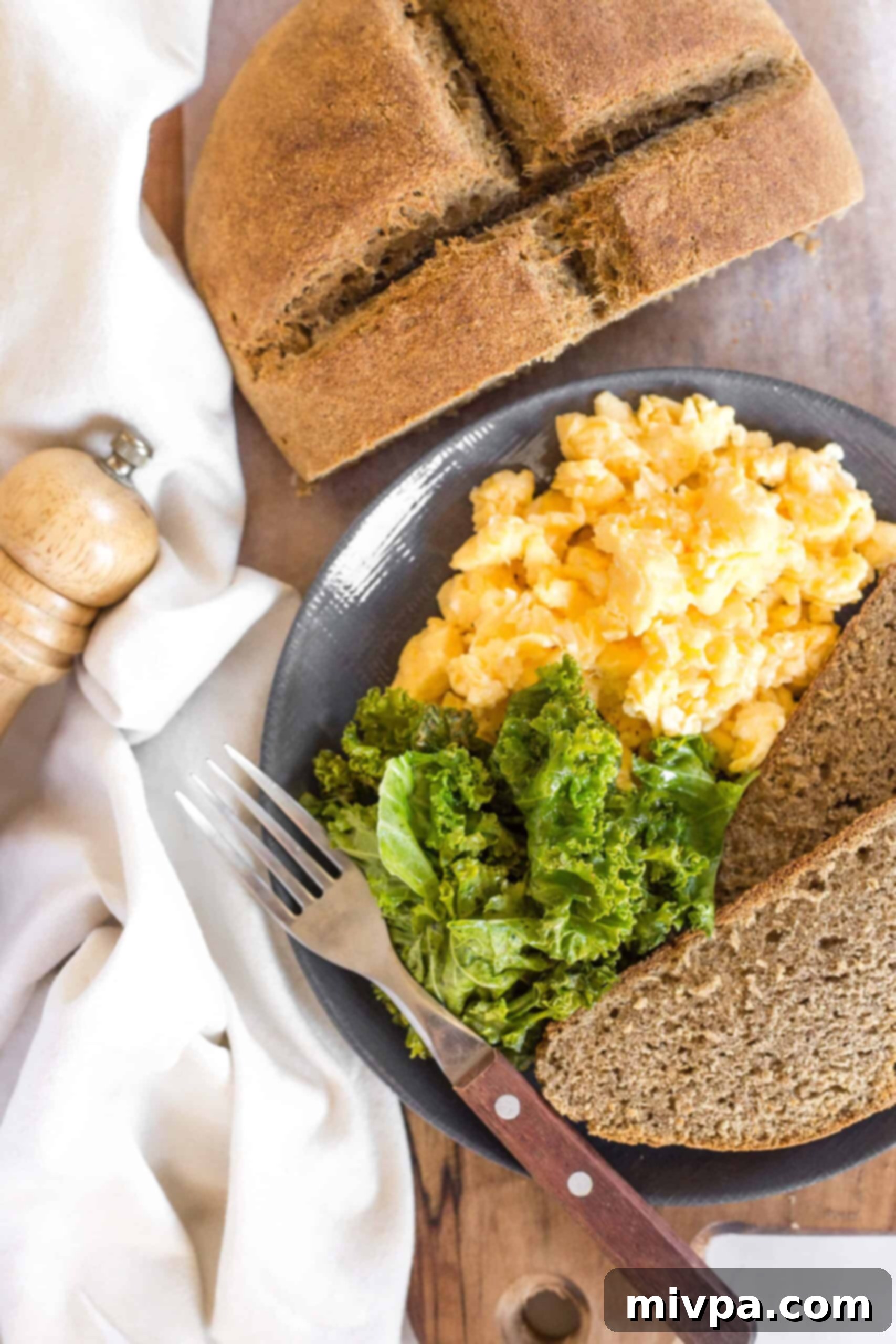
Delicious Pairings for Your Gluten-Free Brown Soda Bread:
- Hearty Beef & Vegetable Stew (Gluten-Free, Dairy-Free): The dense texture of this bread is perfect for soaking up rich stew broth.
- Creamy Beef Stroganoff (Gluten-Free, Dairy-Free): A comforting and satisfying combination that will delight your taste buds.
- Flavorful Venison Stew (Gluten-Free, Dairy-Free): For a truly robust meal, pair this bread with a savory venison stew.
- Slow Cooker Green Chili Chicken (Gluten-Free, Dairy-Free): A wonderful counterpoint to the subtle spice of this slow-cooked chicken dish.
More Gluten-Free Bread Recipes You’ll Adore:
- Gluten-Free Chocolate Chip Pumpkin Bread (Dairy-Free)
- Easy Gluten-Free Drop Biscuits (Dairy-Free)
- Gluten-Free Vegan Bagels (Chewy and Tender!)
- Egg-Free Gluten-Free Bread (So Tender!)
P.S. If you try this wholesome recipe, I would be absolutely thrilled if you could leave a star rating below and/or share your thoughts in the comment section further down the page. Your feedback is invaluable to me and helps others discover these delicious recipes. Don’t forget to explore my entire Recipe Index for a treasure trove of culinary delights on the blog. You can also connect with me on Pinterest, Facebook, or Instagram! Be sure to sign up for my Email List to receive fresh new recipes directly in your inbox each week!
Print
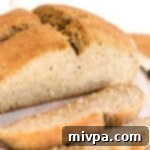
Gluten-Free Irish Brown Bread (Dairy-Free, Vegan)
5 Stars
4 Stars
3 Stars
2 Stars
1 Star
5 from 2 reviews
- Author: Felicia Lim
- Total Time: 1 hour
- Yield: 8 servings
- Diet: Gluten Free
Description
Ready in an hour, this hearty loaf of gluten-free Irish brown bread is super easy to make, no kneading required! With a tight crumb characteristic of soda bread and slightly sweetened with maple syrup, it’s perfect for St. Patrick’s day or anytime. Totally dairy-free and vegan too, but no one would care.
Ingredients
Units
Scale
- 2 cups brown rice flour
- 1 cup millet flour
- 1 cup sorghum flour
- 2 tablespoons psyllium husk powder
- 1 teaspoon baking soda
- 2 teaspoons baking powder
- 3 tablespoons maple syrup
- 2 cups warm dairy-free buttermilk
- 2 tablespoons sunflower oil
Instructions
- Preheat and Line: Preheat your oven to 350°F (175°C). Prepare a medium cast iron skillet or a baking sheet by lining it thoroughly with parchment paper. Ensure the paper covers the bottom and extends slightly up the sides to prevent any sticking.
- Whisk Dry Ingredients: In a large mixing bowl, combine all the dry ingredients: brown rice flour, millet flour, sorghum flour, psyllium husk powder, baking soda, and baking powder. Whisk them together vigorously for at least 30 seconds to ensure they are completely blended and evenly distributed. This step is crucial for the bread’s texture and rise.
- Add Wet Ingredients: To the bowl of whisked dry ingredients, add the maple syrup, the pre-warmed dairy-free buttermilk mixture, and the sunflower oil. Using a spatula or wooden spoon, mix everything until a thick, homogeneous dough forms. The dough will be somewhat sticky, which is normal for this type of quick bread. Avoid overmixing; just combine until no dry patches remain.
- Shape Dough in Ball and Place in Skillet: Lightly flour your hands (or oil them if the dough is very sticky). Gently gather the dough and shape it into a neat round ball. Carefully transfer this dough ball to the center of your prepared, parchment-lined cast iron skillet or baking sheet.
- Cut a Cross: Using a sharp, non-serrated knife, cut a deep cross on the top surface of the dough. These two perpendicular lines should extend almost to the edge of the dough, cutting about two-thirds of the way down into the loaf. This traditional cut helps the bread bake evenly from the center outwards.
- Bake Until Golden Brown: Place the skillet or baking sheet with the dough into your preheated oven. Bake for approximately 50 minutes. The bread is done when it’s beautifully golden brown on top, and a toothpick or thin skewer inserted into the thickest part of the center comes out completely clean, indicating no wet dough inside.
- Cool Completely Before Slicing: Once baked, remove the Irish soda bread from the oven and carefully transfer it (still on the parchment paper) to a wire rack. It is absolutely essential to let the loaf cool completely to room temperature before attempting to slice it. This cooling period allows the internal structure to set, preventing a gummy texture and ensuring perfect slices.
Notes
Brown Rice Flour: I like using brown rice flour as the base of this Irish brown bread recipe. Alternatively, you may also use a good-quality gluten-free all-purpose flour blend if you prefer.
Millet Flour: You can make your own millet flour or buy a packet. If you don’t have millet flour, you can substitute it with sorghum flour, amaranth flour, or buckwheat flour.
Sorghum Flour: If you don’t have sorghum flour, you can use millet flour, amaranth flour, or buckwheat flour.
Psyllium Husk Powder: Psyllium husk powder is the substitute for gluten in this gluten-free recipe and helps to bind the ingredients together. Make sure you use the powder version. If you only have access to whole psyllium husks, you can grind the husks in a high-speed blender or coffee grinder until you get a fine powder.
Baking Soda: Since Irish brown soda bread is leavened with baking soda, this is an important ingredient.
Baking Powder: In addition to baking soda, we’re also using baking powder to help the dough rise even more. If you have Celiac disease or are gluten-intolerant, make sure to use certified gluten-free baking powder.
Maple Syrup: I like using maple syrup to sweeten this Irish brown bread. Alternatively, you may use molasses or agave nectar. If you are not vegan, you may also use honey instead.
Dairy-Free Buttermilk: To help the batter rise, we need to create an acidic environment, and the sourness of the buttermilk will do just that. If you don’t have buttermilk, simply combine 2 cups of non-dairy milk (such as almond milk or cashew milk) with 2 tablespoons of white vinegar or lemon juice and let it sit for a while. Alternatively, if you are not lactose-intolerant, you may use normal buttermilk instead. I like to warm the buttermilk a little before adding it to the dry ingredients for best results.
Sunflower Oil: I like using sunflower oil because I always have a bottle of it on hand. Alternatively, you may also use another vegetable oil such as olive oil, avocado oil, or melted coconut oil.
Storing/Freezing: To store, place the cooled gluten-free brown soda bread in an airtight container and refrigerate for up to 5 days. To freeze, wrap the fully cooled loaf in various layers of plastic wrap and freeze for up to 2 months.
Adapted from: King Arthur Baking
- Prep Time: 10 mins
- Cook Time: 50 mins
- Category: Bread
- Method: Baking
- Cuisine: Irish
